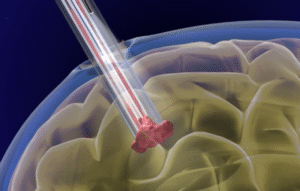Minimally Invasive Brain Tumour Removal in Delhi
Minimally invasive brain surgery is a neurosurgical technique that involves accessing the brain through small incisions or natural openings, such as the nose or mouth, rather than large open craniotomies. This approach uses advanced technology, including specialized instruments, endoscopes, and imaging techniques, to visualize and treat brain conditions with minimal disruption to surrounding tissues.
This technique is often employed to treat conditions such as brain tumours, aneurysms, and other neurological disorders. It allows for effective intervention while promoting quicker healing and improved patient outcomes.
Dr. Vikas Gupta, a renowned neurosurgeon, emphasizes the impact of minimally invasive brain surgery, stating, “This advanced approach is transforming the treatment of complex brain conditions. By leveraging cutting-edge technology and precision techniques, we are able to achieve faster recoveries for patients while minimizing postoperative complications compared to conventional brain surgeries.”
What Are the Types of Minimally Invasive Brain Surgery?
There are several types of minimally invasive brain surgery, each tailored to treat specific conditions. Some of the most common types include:
- Endoscopic Brain Surgery involves using a thin, flexible tube (endoscope) with a camera and specialized tools to access and treat brain conditions. It’s commonly used to treat conditions like pituitary tumours or remove fluid buildup (hydrocephalus).
- Keyhole Craniotomy: In this procedure, a small “keyhole” incision is made in the skull to access specific areas of the brain. It’s used for treating brain tumours, aneurysms, and vascular malformations.
- Stereotactic Radiosurgery (SRS): This non-invasive technique uses highly focused radiation beams to target and destroys abnormal brain tissue, such as tumors or arteriovenous malformations (AVMs), without the need for incisions.
- Laser Ablation Surgery: It involves using a laser probe inserted through a tiny incision to destroy abnormal brain tissue. It’s commonly used for epilepsy and certain types of brain tumours.
Each type of minimally invasive brain surgery offers specific benefits, depending on the condition being treated. Your neurosurgeon will recommend the most appropriate technique based on your diagnosis and individual needs.
What are the Advantages of Minimally Invasive Brain Surgery?
Minimally invasive brain surgery has revolutionized the way neurosurgeons approach complex brain conditions. Utilizing advanced techniques and specialized tools, this method allows surgeons to treat brain tumours, aneurysms, and other neurological disorders with smaller incisions, resulting in less trauma to the surrounding tissues. Some of the key benefits of minimally invasive brain surgery include:
- Reduced Recovery Time: Because the incisions are smaller and there’s less trauma to the brain and surrounding tissues, patients typically experience a faster recovery. Many can return to daily activities within weeks rather than months.
- Lower Risk of Infection and Complications: Smaller incisions mean reduced exposure to infections and a lower chance of complications like excessive bleeding or damage to healthy brain tissue.
- Less Scarring and Pain: Patients generally experience less postoperative pain, require fewer pain medications, and have smaller, less noticeable scars.
- Shorter Hospital Stays: Most patients undergoing MIBS can expect a significantly shorter hospital stay, sometimes as short as a few days, compared to the longer stays associated with traditional surgery.
- Enhanced Precision: The use of advanced imaging and robotic assistance in MIBS allows for greater accuracy, reducing the risk of collateral damage to healthy brain structures.
Minimally invasive brain surgery is generally considered safe and effective when performed by an experienced neurosurgeon using the latest technologies. However, as with any surgery, there are risks involved, including:
- Infection: Although the risk is lower than with traditional surgery, infections are still a possibility.
- Bleeding: Any surgical procedure carries a risk of bleeding, though the chances of bleeding are less in MIBS.
- Anaesthesia Complications: Rarely, patients may have reactions to anaesthesia.
- Residual Symptoms: In some cases, patients may continue to experience symptoms related to their condition even after surgery, and additional treatments may be required.
One of Dr. Vikas Gupta’s patients, Mrs. Shalini Rao, shared her experience, stating, “I was diagnosed with a brain tumour, and the thought of surgery terrified me. However, Dr. Vikas Gupta assured me that minimally invasive brain surgery would be the best option. Thanks to his expertise and care, my recovery was swift, and I was back on my feet much sooner than I expected. The pain was minimal, and I hardly have any visible scars. I’m incredibly grateful to Dr. Gupta and his team.”
What is the Cost of Minimally Invasive Brain Surgery in India?
Minimally invasive brain surgery (MIBS) in India offers a more affordable option compared to many other countries while still providing high-quality care and access to advanced medical technologies. The cost of the procedure can vary based on the type of surgery, the hospital, the complexity of the condition, and the surgeon’s expertise. On average, the cost of MIBS in India ranges from INR 2,50,000 to INR 8,00,000.
Here is a breakdown of the costs for different types of minimally invasive brain surgeries in India:
- Endoscopic Brain Surgery: INR 3,00,000 – INR 5,00,000
- Keyhole Craniotomy: INR 4,00,000 – INR 7,00,000
- Stereotactic Radiosurgery (SRS): INR 2,50,000 – INR 6,00,000
- Laser Ablation Surgery: INR 4,00,000 – INR 8,00,000
It’s important to note that the total cost may include hospital charges, surgeon fees, preoperative tests, and postoperative care.
Conclusion
Minimally invasive brain surgery offers significant advantages, including shorter recovery times, less pain, and reduced scarring compared to traditional open surgery. With advancements in medical technology, various types of minimally invasive procedures are now available to treat complex brain conditions with greater precision and safety. While the cost of these surgeries in India is relatively affordable compared to other countries, it is important to consult with your surgeon and healthcare provider to understand the specific procedure, risks, and benefits for your condition. For most patients, minimally invasive brain surgery is a safe and effective option, offering faster recovery and improved outcomes.
FAQs
1. How long does recovery take after minimally invasive brain surgery?
Recovery typically takes 2 to 4 weeks and can vary depending on the type of surgery, as well as the patient’s overall health.
2. Who is a candidate for minimally invasive brain surgery?
Patients with specific brain conditions like tumours or aneurysms, depending on health and condition location.
3. What technologies are used in minimally invasive brain surgery?
Endoscopes, microscopes, lasers, and robotic systems are commonly used.
4. How long does a minimally invasive brain surgery procedure take?
Usually between 2 to 6 hours.
5. Can minimally invasive brain surgery be performed on children?
Yes, it can be used for conditions like tumours or epilepsy in children.
Related Blogs

From Diagnosis to Treatment: What Role Does Neuro-Oncology Play in Enhancing Patient Outcomes?
According to the World Health Organization (WHO), primary brain tumors account for approximately 2% of…
Read Article →
Role of Neuro Intervention in Neurological Care
In healthcare, neuro-interventional neurosurgery or neurointervention is one of the youngest subspecialties of neuroscience. This…
Read Article →
